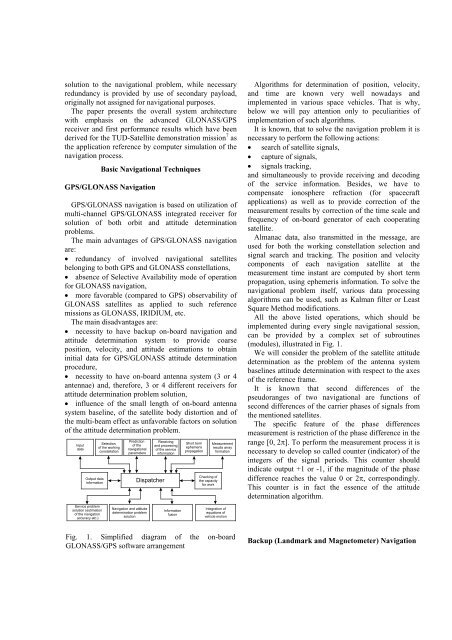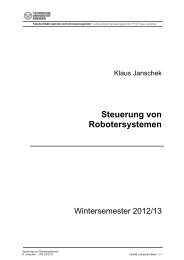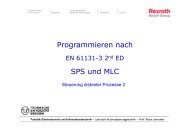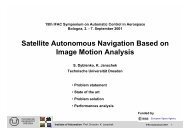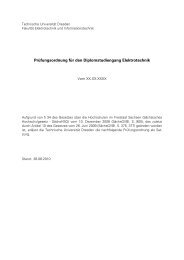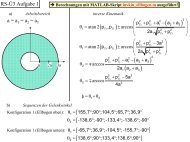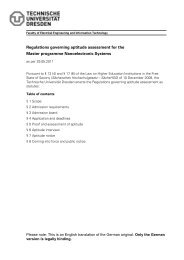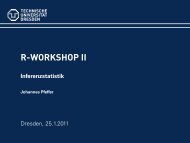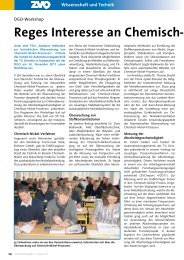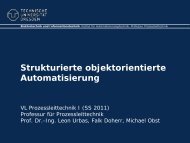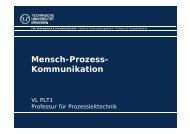the advanced concept of small satellite integrated navigation system ...
the advanced concept of small satellite integrated navigation system ...
the advanced concept of small satellite integrated navigation system ...
You also want an ePaper? Increase the reach of your titles
YUMPU automatically turns print PDFs into web optimized ePapers that Google loves.
solution to <strong>the</strong> <strong>navigation</strong>al problem, while necessary<br />
redundancy is provided by use <strong>of</strong> secondary payload,<br />
originally not assigned for <strong>navigation</strong>al purposes.<br />
The paper presents <strong>the</strong> overall <strong>system</strong> architecture<br />
with emphasis on <strong>the</strong> <strong>advanced</strong> GLONASS/GPS<br />
receiver and first performance results which have been<br />
derived for <strong>the</strong> TUD-Satellite demonstration mission 7 as<br />
<strong>the</strong> application reference by computer simulation <strong>of</strong> <strong>the</strong><br />
<strong>navigation</strong> process.<br />
Basic Navigational Techniques<br />
GPS/GLONASS Navigation<br />
GPS/GLONASS <strong>navigation</strong> is based on utilization <strong>of</strong><br />
multi-channel GPS/GLONASS <strong>integrated</strong> receiver for<br />
solution <strong>of</strong> both orbit and attitude determination<br />
problems.<br />
The main advantages <strong>of</strong> GPS/GLONASS <strong>navigation</strong><br />
are:<br />
• redundancy <strong>of</strong> involved <strong>navigation</strong>al <strong>satellite</strong>s<br />
belonging to both GPS and GLONASS constellations,<br />
• absence <strong>of</strong> Selective Availability mode <strong>of</strong> operation<br />
for GLONASS <strong>navigation</strong>,<br />
• more favorable (compared to GPS) observability <strong>of</strong><br />
GLONASS <strong>satellite</strong>s as applied to such reference<br />
missions as GLONASS, IRIDIUM, etc.<br />
The main disadvantages are:<br />
• necessity to have backup on-board <strong>navigation</strong> and<br />
attitude determination <strong>system</strong> to provide coarse<br />
position, velocity, and attitude estimations to obtain<br />
initial data for GPS/GLONASS attitude determination<br />
procedure,<br />
• necessity to have on-board antenna <strong>system</strong> (3 or 4<br />
antennae) and, <strong>the</strong>refore, 3 or 4 different receivers for<br />
attitude determination problem solution,<br />
• influence <strong>of</strong> <strong>the</strong> <strong>small</strong> length <strong>of</strong> on-board antenna<br />
<strong>system</strong> baseline, <strong>of</strong> <strong>the</strong> <strong>satellite</strong> body distortion and <strong>of</strong><br />
<strong>the</strong> multi-beam effect as unfavorable factors on solution<br />
<strong>of</strong> <strong>the</strong> attitude determination problem.<br />
Fig. 1. Simplified diagram <strong>of</strong> <strong>the</strong> on-board<br />
GLONASS/GPS s<strong>of</strong>tware arrangement<br />
Algorithms for determination <strong>of</strong> position, velocity,<br />
and time are known very well nowadays and<br />
implemented in various space vehicles. That is why,<br />
below we will pay attention only to peculiarities <strong>of</strong><br />
implementation <strong>of</strong> such algorithms.<br />
It is known, that to solve <strong>the</strong> <strong>navigation</strong> problem it is<br />
necessary to perform <strong>the</strong> following actions:<br />
• search <strong>of</strong> <strong>satellite</strong> signals,<br />
• capture <strong>of</strong> signals,<br />
• signals tracking,<br />
and simultaneously to provide receiving and decoding<br />
<strong>of</strong> <strong>the</strong> service information. Besides, we have to<br />
compensate ionosphere refraction (for spacecraft<br />
applications) as well as to provide correction <strong>of</strong> <strong>the</strong><br />
measurement results by correction <strong>of</strong> <strong>the</strong> time scale and<br />
frequency <strong>of</strong> on-board generator <strong>of</strong> each cooperating<br />
<strong>satellite</strong>.<br />
Almanac data, also transmitted in <strong>the</strong> message, are<br />
used for both <strong>the</strong> working constellation selection and<br />
signal search and tracking. The position and velocity<br />
components <strong>of</strong> each <strong>navigation</strong> <strong>satellite</strong> at <strong>the</strong><br />
measurement time instant are computed by short term<br />
propagation, using ephemeris information. To solve <strong>the</strong><br />
<strong>navigation</strong>al problem itself, various data processing<br />
algorithms can be used, such as Kalman filter or Least<br />
Square Method modifications.<br />
All <strong>the</strong> above listed operations, which should be<br />
implemented during every single <strong>navigation</strong>al session,<br />
can be provided by a complex set <strong>of</strong> subroutines<br />
(modules), illustrated in Fig. 1.<br />
We will consider <strong>the</strong> problem <strong>of</strong> <strong>the</strong> <strong>satellite</strong> attitude<br />
determination as <strong>the</strong> problem <strong>of</strong> <strong>the</strong> antenna <strong>system</strong><br />
baselines attitude determination with respect to <strong>the</strong> axes<br />
<strong>of</strong> <strong>the</strong> reference frame.<br />
It is known that second differences <strong>of</strong> <strong>the</strong><br />
pseudoranges <strong>of</strong> two <strong>navigation</strong>al are functions <strong>of</strong><br />
second differences <strong>of</strong> <strong>the</strong> carrier phases <strong>of</strong> signals from<br />
<strong>the</strong> mentioned <strong>satellite</strong>s.<br />
The specific feature <strong>of</strong> <strong>the</strong> phase differences<br />
measurement is restriction <strong>of</strong> <strong>the</strong> phase difference in <strong>the</strong><br />
range [0, 2π]. To perform <strong>the</strong> measurement process it is<br />
necessary to develop so called counter (indicator) <strong>of</strong> <strong>the</strong><br />
integers <strong>of</strong> <strong>the</strong> signal periods. This counter should<br />
indicate output +1 or -1, if <strong>the</strong> magnitude <strong>of</strong> <strong>the</strong> phase<br />
difference reaches <strong>the</strong> value 0 or 2π, correspondingly.<br />
This counter is in fact <strong>the</strong> essence <strong>of</strong> <strong>the</strong> attitude<br />
determination algorithm.<br />
Backup (Landmark and Magnetometer) Navigation


